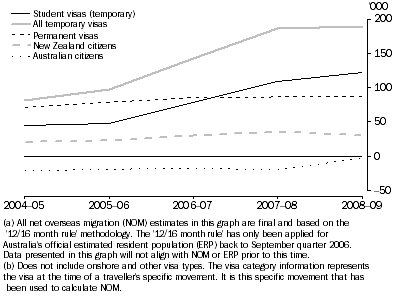INTRODUCTION
The international education sector is important to Australia for a number of reasons. In 2010, the Australian Government appointed the Hon Michael Knight AO to undertake a strategic review of the student visa program. It was noted in the call for submissions that:
'The international education sector is important to Australia in establishing bilateral ties with key partner countries and supports employment in a broad range of occupations in the Australian economy as well as delivering high-value skills to the economy.'(footnote 1)
The movement of international students into and out of Australia is measured from information provided on incoming and outgoing passenger cards. This information allows for the calculation of net overseas migration (NOM) and thus, students contributing to Australia's estimated resident population (ERP). In 2008-09, the net number of international students being added to Australia's population reached an all time high of 122,400 students. These international students contributed 27% of Australia's population growth in 2008-09.
The education industry has generated a substantial income for the Australian economy. The Australian Bureau of Statistics (ABS) estimated that in 2008-09, education related spending by international students (including New Zealand citizens), which includes tuition fees and living expenses, was $15.9 billion in export earnings. This was nearly double that estimated in 2004-05, $8.0 billion.(footnote 2)
This article considers those people travelling on temporary student visas who arrive in, or depart from, Australia and the contribution that they make to NOM and hence the official population of Australia. The following analysis on international students is split into two main sections. The first section, with the bulk of the analysis, uses ABS data looking at international students who are included in NOM. It examines various characteristics of these international students including age, sex, visa subclass, country of birth and the state or territory in which they usually reside in Australia. These characteristics are only available with final NOM data from the ABS and the data in this article are the most recent available. Due to the time lag required for final NOM data, the aim of the second section is to use data from the Australian Government Department of Immigration and Citizenship (DIAC) on visa grants to give an indication of the current trends on various student visas.
It is important to note that international students travel on a student visa which is a temporary visa issued by DIAC. Therefore, in the majority of cases, a student's duration in the official population count is for a temporary period of time. The exceptions are for those students who apply for and are granted permanent residency whilst onshore.
While the temporary visa group (which includes international students) is one of the major groups contributing to NOM, it has become increasing significant (see figure 6.1). This is mainly due to the increase in student numbers over recent years. Between 2004-05 and 2008-09, the temporary visa group averaged 62% of NOM while the student visa subgroup averaged 36% of NOM. By 2008-09, the student visa subgroup was by far the largest subgroup contributing to Australia's population growth.
6.1 NOM(a), Major groups(b) and student visas
- Australia
- 2004-05 to 2008-09

1 DIAC 2011, Visa, Immigration and Refugees, Student Visa Program Review
<back
2 International Trade in Goods and Services, Australia, Apr 2011, cat. no. 5368.0, monthly
<back
1 APH 2010, Overseas students: immigration policy changes 1997–May 2010, p various.
<back
2 APH 2010, Overseas students: immigration policy changes 1997–May 2010, p 13.
<back
 Print Page
Print Page
 Print All
Print All